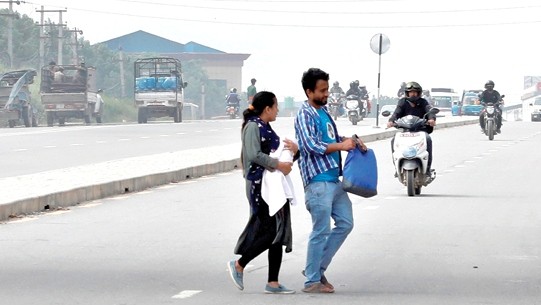Funding gap jolts Nepali roads

By A Staff Reporter
Kathmandu, Sept. 15: Nepali road sector has suffered from chronic under-investment, creating a high investment backlog, the World Bank concluded in its recent report on ‘Nepal Infrastructure Sector Assessment’. “The annual funding allocation for the strategic road network maintenance in the past five years has been, on average, 60 per cent short of the annual requirement,” said the multilateral donor.
The funding gap in the road sector between 2014 and 2018 was 68 per cent. According to the Department of Roads (DoR), the funding requirement for the road maintenance was Rs. 16.18 billion in 2017/18 but the budget allocation was Rs. 3.09 billion. The year witnessed about 81 per cent budget gap in road maintenance.
Likewise, in 2016/17, the government allocated Rs. 5.60 billion budget against the need of 16.77 billion thus creating budget gap of 67 per cent. In contrast, the Strategic Investment Plan prepared by the DoR and the Ministry of Physical Infrastructure and Transport estimated that the road sector development demanded about Rs. 700 billion from 2016 to 2020.
Nepal needs about Rs. 112 billion for basic road expansion, development of main highways and reconstruction of earthquake affected roads and bridges and Rs. 36 billion for highway maintenance for 2016-2020 period.
The strategic plan estimates that the country needs Rs. 649.1 billion for 2020-2025 and Rs. 860 billion for 2025-2030 period.
But, due to the devolution process in the recently implemented federal structure of the country, the legal and institutional setup for roads is currently in flux, read the report.
While the road development is facing budget crisis and policies are not yet fully devised to manage various types of roads, about 77 per cent national highways are in poor status. According to the report, transport costs are high due to poor road quality at high gradients, leading to long journey times and high fuel consumption.
Meanwhile, available funds are not fully utilised due to weak capacity for procurement, contact management, and implementation, and government agencies in procurement management, construction supervision and contract management suffer from weak institutional capacity.
The report makes a note that the DoR faces lack of sufficient, qualified personnel for construction supervision and contract management as a result even low budget allocations are not fully absorbed. The Ministry of Finance allocates budget about 30 per cent of the total requirement and the DoR spends only about 80 per cent of that money.
The World Bank also concludes that the private sector capacity is also weak. “Delays in project completion and poor-quality construction are common and these are mainly due to inefficient management and low financial capacity,” it said.
Recent News

Do not make expressions casting dout on election: EC
14 Apr, 2022
CM Bhatta says may New Year 2079 BS inspire positive thinking
14 Apr, 2022
Three new cases, 44 recoveries in 24 hours
14 Apr, 2022
689 climbers of 84 teams so far acquire permits for climbing various peaks this spring season
14 Apr, 2022
How the rising cost of living crisis is impacting Nepal
14 Apr, 2022
US military confirms an interstellar meteor collided with Earth
14 Apr, 2022
Valneva Covid vaccine approved for use in UK
14 Apr, 2022
Chair Prachanda highlights need of unity among Maoist, Communist forces
14 Apr, 2022
Ranbir Kapoor and Alia Bhatt: Bollywood toasts star couple on wedding
14 Apr, 2022
President Bhandari confers decorations (Photo Feature)
14 Apr, 2022











